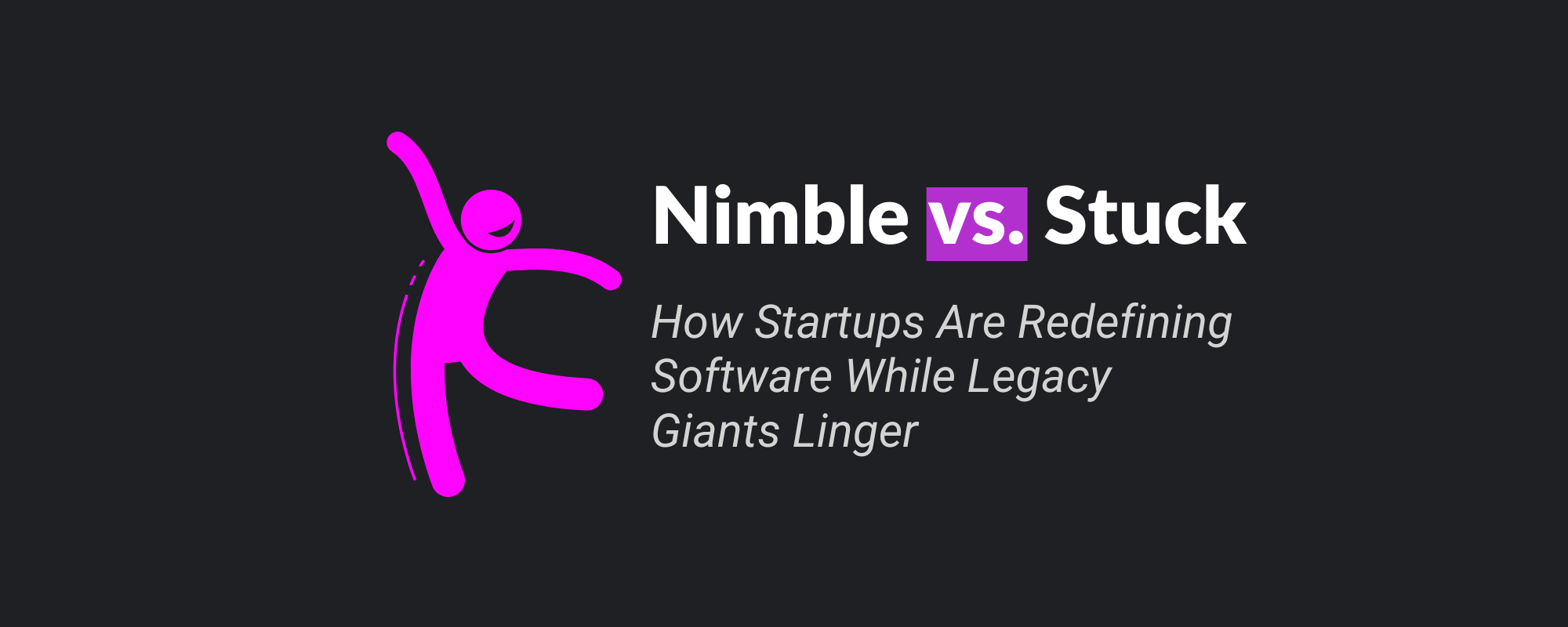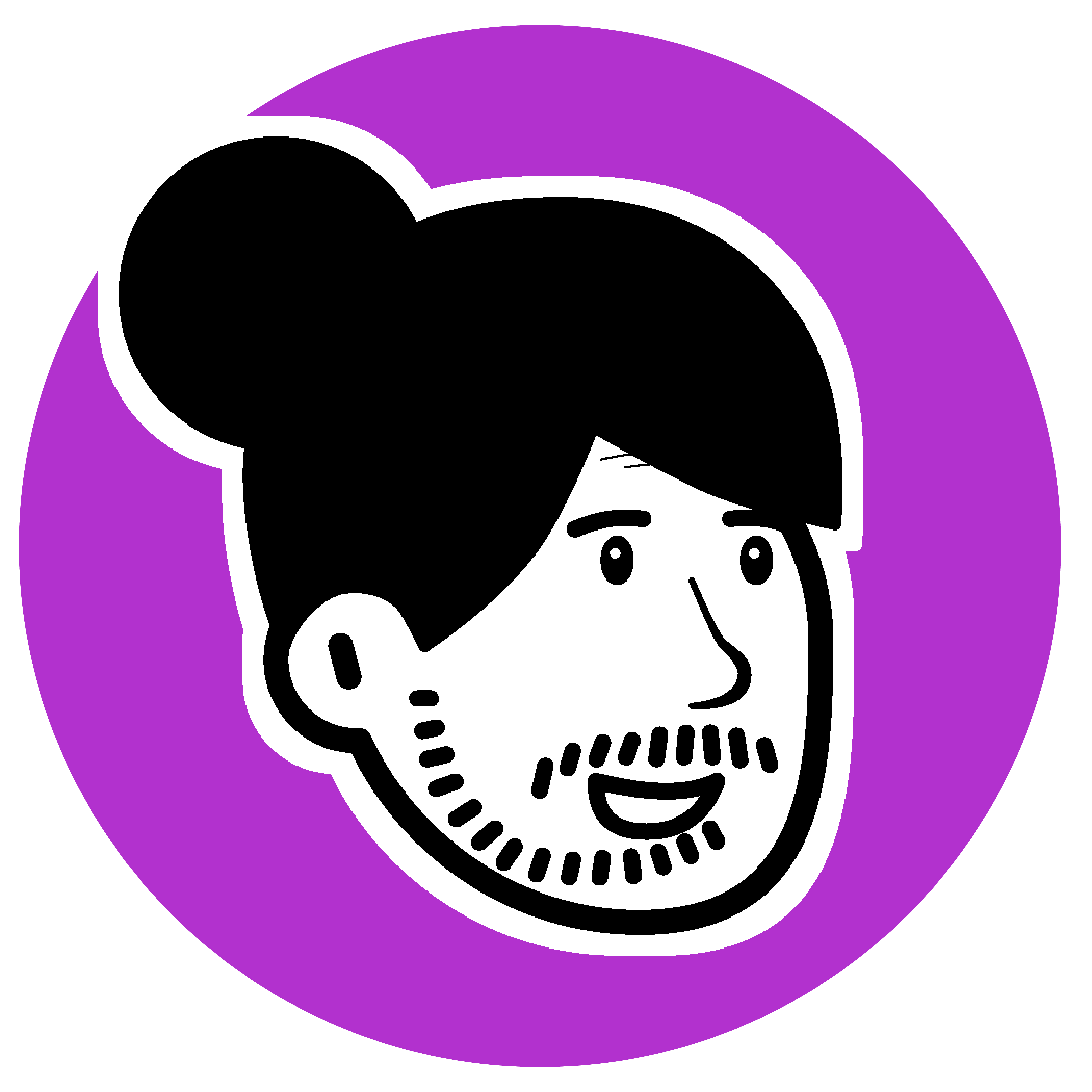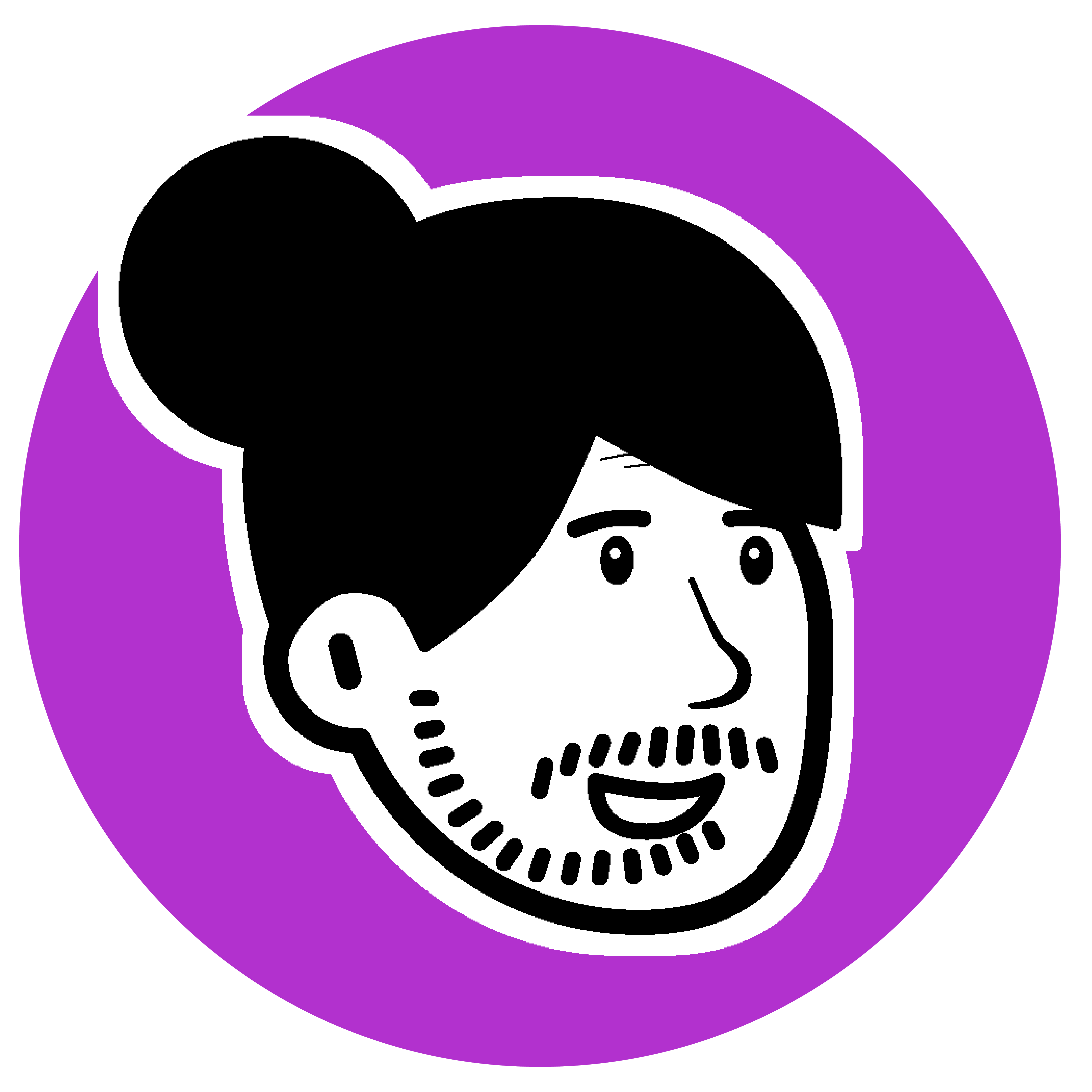Nimble vs. Stuck: How Startups Are Redefining Software While Legacy Giants Linger

Somewhere between the first iPhone unveiling and today’s bewildering variety of digital tools, tech went through a wild transformation. From the birth of cloud computing that changed how we store and access data, to the rise of AI that brought tools like ChatGPT into our homes, the shift has been nothing short of revolutionary. We went from the novelty of having a touchscreen device in our pockets to widespread adoption of AI-driven assistants like ChatGPT—tools that have fundamentally changed how we interact with technology. We went from 'Ooh, a touchscreen!' to a plethora of AI-driven solutions that reshape how we work, live, and play. Somewhere along the way, it feels like the big tech companies forgot what it means to truly understand their users. Meanwhile, nimble startups started building solutions that directly addressed user frustrations—solutions that just worked, without the corporate baggage. These startups seemed to remember the pain of rigid tools and knew that people wanted more flexibility and a sense of control. This shift has been fascinating: tech giants, once the most innovative players, are now struggling to keep up with startups that are genuinely in tune with what we need today.
Flexibility vs. Rigidity
Let’s talk Google Workspace. For years, it’s been the standard for cloud-based collaboration—Docs, Sheets, Gmail, all nicely bundled in one ecosystem. But do you ever get the feeling that it’s a bit like your uncle’s old recliner? Functional, comfortable, but kind of... stuck in time? Enter Notion. People now want more than just a tool—they want a workspace that adapts to their needs, with the sleekness of a modern office chair that not only supports but moves with them. Notion’s integrations—from upcoming email clients to its adaptable calendar—aren’t just added features; they’re signals to users: We get what you need. And there's something undeniably appealing about feeling understood.
Notion also took it up a notch with NotionAI, launched exactly when people needed a smarter, more intuitive workflow assistant. NotionAI helps users streamline content creation, such as drafting blog posts or generating project outlines, and assists with task management by summarizing meeting notes or creating to-do lists automatically. For instance, NotionAI helps users quickly generate meeting notes or brainstorm content ideas, making the platform an indispensable part of their productivity toolkit. It’s that kind of agility and keen user understanding that has set Notion apart. Meanwhile, Google’s Gemini, another AI project, seems to be struggling to strike the same chord, appearing more like a rushed afterthought compared to Notion's well-timed and well-integrated AI solutions. It’s a classic story of nimble, user-focused startups outpacing the big guys who might have grown a little too comfortable in their old chairs. .
Google Workspace, in contrast, seems to deliver what Google assumes you need, often presenting limited customization options and a more rigid structure. It's ironic, considering that once upon a time, Google Docs disrupted Microsoft Office by offering a fresh, collaborative experience. Now, Google finds itself on the other side of the equation. There’s a subtle but significant difference—one that explains why so many are making the switch to solutions like Notion, where you get to create exactly what fits you best. It’s the difference between eating what’s placed in front of you and being the chef in your own kitchen. If the pandemic taught us anything, it’s that people crave control, even if it's just over where to stick a digital note.
Then there’s Adobe. Remember when they bought Figma for $20 billion? That move wasn’t about innovation—it was about survival. Adobe saw Figma becoming the design tool of choice, and instead of improving their own offerings, they bought out the competition. It’s like buying out the bustling lemonade stand across the street because everyone prefers it—a move that signals desperation rather than genuine innovation. Adobe wasn’t aiming to collaborate; they were trying to save Creative Suite from a competitor that truly understood what designers wanted.
And what about Microsoft? Their acquisition of GitHub stands out as a prime example of a legacy company betting on community-driven, flexible solutions. GitHub, being the epicenter of open-source projects, gave Microsoft a golden opportunity to reconnect with the developer community. Remember when Microsoft was the company of proprietary, buttoned-up software that developers often avoided? GitHub changed that—opening the doors for Microsoft to build bridges to a modern generation of developers who value open ecosystems and freedom of customization.
Now let’s take Slack. It was a cool upstart until Microsoft Teams came into the picture with a very familiar-looking interface. Microsoft used its bundling capabilities to offer Teams with existing Office subscriptions, effectively gate-crashing Slack's market. The key difference? Slack built its platform around user delight; Microsoft leveraged its existing dominance. There’s a fundamental contrast here—being genuinely innovative versus simply being strategic.
COVID-19, Startups, and a New Wave of Disruption
COVID-19 was like a shot of adrenaline for the tech industry, waking everyone up to just how insufficient the old tools had become. For example, traditional VPN-based remote work setups quickly became cumbersome and outdated, leading to the rise of more flexible, cloud-based collaboration tools. We needed software that was flexible, adaptable, and empathetic—something that felt like it truly understood what we were going through. Slack, Zoom, Notion—these platforms thrived not because they existed, but because they evolved alongside us. Slack introduced features like huddles, making spontaneous voice chats possible, Zoom continuously improved video quality and added breakout rooms for better remote collaboration, and Notion kept adapting with new templates and integrations that helped users manage both work and personal projects during challenging times. Meanwhile, legacy systems felt rigid, as if we were trying to stretch in jeans that were two sizes too small.
Here’s where the real disruption began: companies that were born during the pandemic have been shaking things up the most. Take OpenAI—barely five years old and already at the forefront of AI advancements with models like ChatGPT. This isn't about flashy tech; it’s about changing the very way we interact with software. It’s about having AI that doesn’t just assist but co-creates. Legacy companies are still figuring out where AI fits, while OpenAI built itself entirely around it from the start.
Then there's Notion, as mentioned earlier. Transforming workspace organization isn’t just about creating another word processor or spreadsheet; it’s about a seamless, integrated experience that grows with the user. It’s about taking the reins and deciding how your digital space should look, feel, and function. And people aren’t just settling for that—they’re demanding it.
Perplexity AI is another fascinating newcomer, creating ripples in AI-powered search. Remember when search was synonymous with Google? Well, Perplexity is taking a swing at that, suggesting that we don’t have to settle for the traditional search experience anymore. It's turning queries into conversations, making search dynamic and far more intuitive. The speed at which these companies are iterating is making Google’s once-revolutionary PageRank look more like an artifact of the early web.
Figma deserves a deeper dive too. While we already talked about Adobe’s buyout, consider why Figma was such a big threat in the first place. It wasn’t just about real-time collaboration or a modern UI—it was about making design a process where everyone could participate. Designers, clients, stakeholders—all collaborating in the same space in real-time. Compare that to Adobe’s Creative Suite, which for years operated as an impenetrable fortress. Figma’s approach was the opposite: open the gates, let everyone in. That’s where the magic happened.
Then there’s Zoom. Before COVID-19, it was just another video conferencing tool, but the pandemic turned it into a verb—“Let’s Zoom.” It wasn't about groundbreaking technology, but about simplicity, reliability, and understanding user pain points that traditional conferencing solutions had ignored. Slack similarly redefined workplace communication by embracing a casual, chat-like interface that made people actually want to interact. Slack made work less like work and more like collaboration, something rigid email threads had failed to do for years.
Airtable and Monday.com both represent a shift toward flexible project management tools. They took the concept of spreadsheets and to-do lists and turned them into something much more intuitive and visual. Legacy project management tools often feel like they were built for accountants rather than for creatives, but these new platforms say: Here’s a blank slate—build your workflow, your way.
Empathy as a Product
Canva and Miro are perhaps the best examples of products that introduced empathy into tech. Canva looked at design tools and realized that most of the world isn’t made up of professional designers. They built something that anyone could use—without needing to understand layers, masks, or vector paths. In doing so, they democratized design, allowing anyone to be creative without the steep learning curve. Canva has, in many ways, made Adobe's Photoshop feel like it's only for the specialists.
Miro, on the other hand, is disrupting the traditional whiteboard experience. When COVID-19 pushed everyone out of conference rooms and into their home offices, people suddenly realized just how much they missed standing in front of a whiteboard with a bunch of markers. Miro stepped in and said, “Hey, that experience can be digital, too.” Not just replicating the physical board, but enhancing it—letting people brainstorm, add sticky notes, create flowcharts, and work across time zones without missing a beat. It transformed collaborative thinking, something legacy software just couldn’t do.
Calendly has taken a seemingly mundane problem—scheduling—and completely rethought it. Have you ever found yourself in a seemingly endless email chain just trying to find a mutually agreeable meeting time? Calendly’s simple approach to letting people book your available slots directly seemed so obvious in hindsight, and yet, it was during the pandemic that Calendly really gained mainstream attention, even though it had been around since 2013. Compare this with the labyrinthine process of using a traditional enterprise calendar, and it’s easy to see why people jumped ship.
Asana and Trello also deserve their due for tackling productivity in ways that older tools couldn’t. Asana took a structured approach to task management, offering clarity and alignment in teams that often felt like they were all rowing in different directions. Trello, with its simple Kanban boards, provided a visual representation of work that made tasks feel more tangible. When people are overwhelmed, they don’t need more features—they need a clearer way to see their work. That’s exactly what these companies delivered.
A Different Breed
It’s not all about collaboration tools, though. Companies like Crowdstrike and Wiz are leading the charge in cybersecurity, and they’re not doing it in the old-fashioned way. Crowdstrike’s cloud-native approach to endpoint protection wasn’t just different—it was necessary. Legacy antivirus solutions felt like trying to keep mosquitoes out by closing a single window while leaving the rest of the house open. Crowdstrike realized that modern security required speed, adaptability, and, above all, intelligence.
Snowflake and Databricks are reshaping the landscape of data. Traditional databases were built on the idea of keeping all your data neatly in one place. But these newcomers are saying, “Why not make data as flexible as the questions we’re asking?” Snowflake made data warehousing agile, while Databricks turned data into an active player, integrating AI and machine learning in ways that made sense for modern business problems.
Palantir Technologies is another name to note, with their focus on AI-powered data analytics. Unlike traditional enterprise software that required you to know exactly what you were looking for, Palantir said: “We’ll help you find it.” They don’t just provide data; they provide insight, something that’s been sorely lacking in older systems that generated reports but didn’t necessarily tell you what was actionable.
Fastly and ControlUp are expanding edge cloud capabilities and transforming the digital employee experience respectively. These aren’t your typical backend services—they’re building the digital infrastructure that supports remote work, real-time data processing, and adaptable environments for hybrid workforces. Fastly isn’t just a CDN; it's the backbone for modern, performant applications. ControlUp, meanwhile, addresses how digital tools affect actual productivity, something legacy IT often overlooks.
Pax8 has also emerged to change how we think about software distribution. A channel company with an AI-powered marketplace, Pax8 makes it easier for small and medium-sized businesses to access the software solutions they need without wading through endless red tape. The big enterprise resellers are finding themselves outpaced, and it’s easy to see why: speed, flexibility, and focus on the customer rather than the provider.
Why New Players Are Winning
There's a major shift happening across all software categories, where new, nimble players are taking over the legacy giants. This is evident not just in productivity tools, but also in browsers, communication, task management, and even creative fields.
Notion vs. Google Workspace: Notion isn’t just competing with Google Workspace, it's capturing the imagination of users who want flexibility and a platform that adapts. The integration of NotionAI and the upcoming Notion Mail is a perfect example of how well they understand the need for smarter, dynamic tools, something that Google’s old school, rigid structure has struggled to match.
Arc (The Browser Company) vs. Chrome, Safari, and Firefox: Browsers were supposed to be gateways to the web, but over time, they became clunky and burdened by features that hardly anyone uses. Arc is turning heads by being much more than a browser—it’s a productivity platform. Users can save workspaces, split tabs into groups, and truly customize the browsing experience. Meanwhile, Chrome, Safari, and Firefox seem to be having a hard time moving beyond the basics.
Slack vs. Microsoft Teams & Google Meet: Slack’s charm lies in the fact that it’s not just functional, but also delightful to use. The casual, almost fun nature of Slack is the polar opposite of Microsoft Teams, which feels very corporate, and Google Meet, which has consistently struggled to match user experience expectations. Slack turned work communication into something that didn’t have to be stiff and formal, and that change resonates strongly, particularly in creative industries.
Todoist & Things vs. Microsoft To-Do & Google Tasks: In the world of task management, Todoist and Things are beating legacy tools like Microsoft To-Do and Google Tasks by offering interfaces that are not only aesthetically pleasing but deeply functional. They’re designed for humans—not just productivity robots. The simplicity and elegance of Things, for instance, turns managing tasks from a chore into something that feels intuitive and even gratifying. Microsoft and Google seem to have missed the memo on this.
Perplexity AI vs. Google Search & Bing: Search is being reinvented right under Google’s nose. Perplexity AI offers conversational search experiences that traditional engines like Google and Bing simply can’t replicate yet. It’s not about keywords anymore—it’s about context, and Perplexity AI understands that. This shift is making Google’s search model look increasingly dated.
Miro vs. Microsoft Whiteboard: When it comes to brainstorming and visual collaboration, Miro offers an experience that’s hard to beat. Microsoft Whiteboard exists, but it doesn’t match the fluidity and creativity that Miro brings to the table. Miro turned digital collaboration into something vibrant and engaging, and it works seamlessly for distributed teams who miss those spontaneous in-office whiteboard sessions.
Canva vs. Adobe Photoshop: While Adobe has long been the king of professional design, Canva tapped into the needs of non-designers by providing an intuitive, drag-and-drop toolset that anyone can use. Photoshop might still be the industry standard for professionals, but Canva has made itself indispensable for everyone else—small businesses, social media managers, and even marketers who need quick but visually appealing solutions.
Reaper & Ableton vs. Pro Tools: In the world of audio production, Reaper and Ableton have become popular among creators who value customization, ease, and affordability. Pro Tools, once the absolute standard for music and audio production, now often feels overengineered and overpriced for what most new artists actually need. Reaper’s flexible pricing and modular structure, combined with Ableton’s user-friendly approach, have democratized audio production in a way Pro Tools never attempted.
DaVinci Resolve vs. Final Cut Pro & Premiere Pro: For video editing, DaVinci Resolve is gaining traction over legacy tools like Apple’s Final Cut Pro and Adobe’s Premiere Pro. Resolve’s free version offers a powerful suite of features that outmatch the capabilities provided by paid versions of its competitors. It’s especially popular among YouTubers and indie filmmakers who need robust tools without the hefty price tag or subscriptions.
Linear vs. Jira: When it comes to project management for developers, Linear is gradually replacing Jira as the go-to tool. Jira’s complexity has made it cumbersome for smaller teams, while Linear provides a lightweight, fast, and intuitive way to track software projects, focusing on flow and efficiency without the overhead that typically accompanies traditional project management software.
The rise of these small, thoughtful startups isn’t just about having the newest tech—it’s about having the right tech. For example, Miro’s collaborative tools allow seamless real-time input across teams, unlike the more limited and less intuitive Microsoft Whiteboard, making Miro a preferred choice for creative brainstorming. For instance, Notion’s ability to integrate AI seamlessly into its workflow or Miro’s intuitive whiteboard tools both reflect a deep understanding of what users actually need, something that legacy giants often miss. These platforms are designed with today’s users in mind: they’re more human, more adaptable, and they actually listen to what people need. They’re built from scratch with empathy and flexibility as foundational principles, something that legacy giants often forget.
Predictions for the Next Decade (2025 to 2035)
Where do we go from here? If the last five years have shown us anything, it's that personalization will be the key. We’re not talking about generic tools anymore; we’re talking about tailor-made experiences that fit into our workflows like perfectly aligned LEGO blocks. Expect software that doesn’t just offer solutions but lets you build your own.
The next decade will also see the rise of AI-driven companions in every aspect of our digital lives. Imagine opening your project management app and having an AI suggest the optimal workflow based on past performance and future predictions. Software that not only responds to our needs but anticipates them, making proactive suggestions based on the intricacies of our own behavior.
Companies like Anthropic and Mistral AI are already leaning into this vision of AI-enhanced workflows, pushing towards Artificial General Intelligence (AGI) and creating open-source models that aim to democratize access to advanced AI capabilities. This isn’t just for tech giants anymore; these capabilities will soon be embedded in the day-to-day tools used by all of us.
If there’s one takeaway from this, it’s this: We’re moving towards a time when the tech that wins will be the tech that evolves with us. Not the tech that insists we evolve with it. The next wave of disruption isn’t about building tools for every scenario but enabling tools to adapt to each user uniquely. Here’s to the next ten years—may they be adaptive, personalized, and entirely tailored to what we truly need.



Discussion